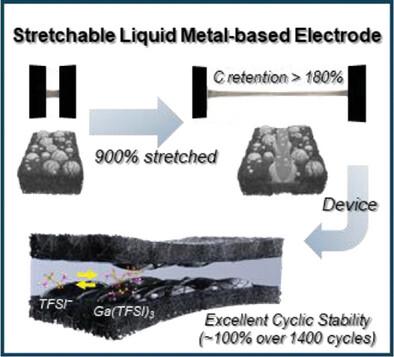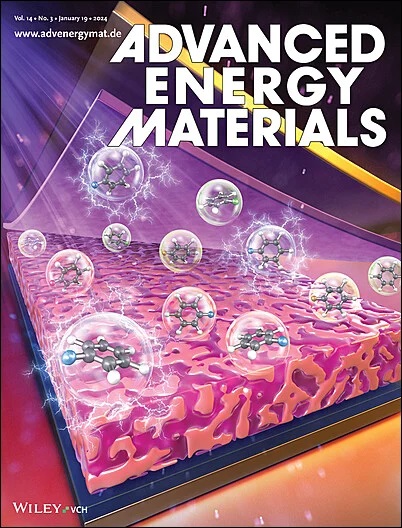Stretchable Energy Storage with Eutectic Gallium Indium Alloy
IF 24.4
1区 材料科学
Q1 CHEMISTRY, PHYSICAL
引用次数: 0
Abstract
The integration of electronics with the human body or wearables necessitates the evolution of energy storage devices capable of seamless adaptation to the conformability of the skin and textiles. This work focuses on developing an intrinsically stretchable electrode prepared by sedimenting the liquid metal particles in a conductive stretchable matrix. The liquid metal-based electrode can be stretched to ≈900% strain, and its conductivity increases by extending to 250% and retaining its initial conductivity at 500% strain. Benefitting from these properties, the assembled all-solid-state energy storage device provides high stretchability of up to 150% strain and a capacity of 0.42 mAh cm−3 at a high coulombic efficiency of 90%. The charge storage mechanism is investigated by probing the electrode/electrolyte interface, uncovering the intricate gallium-bis(trifluoromethane)sulfonimide (Ga-TFSI) complexation during electrochemical cycling through in situ Raman spectroscopy, ex situ X-ray photoelectron spectroscopy (XPS) analyses, and density functional theory (DFT) calculations. This work offers a promising avenue for the advancement of stretchable batteries.

采用共晶镓铟合金的可拉伸储能技术
要将电子器件与人体或可穿戴设备结合起来,就必须开发出能够无缝适应皮肤和纺织品保形性的储能设备。这项工作的重点是开发一种本征可拉伸电极,其制备方法是将液态金属颗粒沉积在导电可拉伸基质中。这种基于液态金属的电极可拉伸至≈900%的应变,其导电性能在拉伸至250%时增加,并在拉伸至500%时保持其初始导电性能。得益于这些特性,组装后的全固态储能装置具有高达 150% 应变的高拉伸性和 0.42 mAh cm-3 的容量,库仑效率高达 90%。研究人员通过原位拉曼光谱、原位 X 射线光电子能谱 (XPS) 分析和密度泛函理论 (DFT) 计算,对电极/电解质界面进行了探测,揭示了电化学循环过程中错综复杂的镓-双(三氟甲烷)磺酰亚胺(Ga-TFSI)络合,从而研究了电荷存储机制。这项工作为推动可拉伸电池的发展提供了一条前景广阔的途径。
本文章由计算机程序翻译,如有差异,请以英文原文为准。
求助全文
约1分钟内获得全文
求助全文
来源期刊

Advanced Energy Materials
CHEMISTRY, PHYSICAL-ENERGY & FUELS
CiteScore
41.90
自引率
4.00%
发文量
889
审稿时长
1.4 months
期刊介绍:
Established in 2011, Advanced Energy Materials is an international, interdisciplinary, English-language journal that focuses on materials used in energy harvesting, conversion, and storage. It is regarded as a top-quality journal alongside Advanced Materials, Advanced Functional Materials, and Small.
With a 2022 Impact Factor of 27.8, Advanced Energy Materials is considered a prime source for the best energy-related research. The journal covers a wide range of topics in energy-related research, including organic and inorganic photovoltaics, batteries and supercapacitors, fuel cells, hydrogen generation and storage, thermoelectrics, water splitting and photocatalysis, solar fuels and thermosolar power, magnetocalorics, and piezoelectronics.
The readership of Advanced Energy Materials includes materials scientists, chemists, physicists, and engineers in both academia and industry. The journal is indexed in various databases and collections, such as Advanced Technologies & Aerospace Database, FIZ Karlsruhe, INSPEC (IET), Science Citation Index Expanded, Technology Collection, and Web of Science, among others.
 求助内容:
求助内容: 应助结果提醒方式:
应助结果提醒方式:


